| UNESCO World Heritage Site | |
|---|---|
 Bhimbetka rock painting Bhimbetka rock painting | |
| Location | Raisen District, Madhya Pradesh, India |
| Criteria | Cultural: (iii), (v) |
| Reference | 925 |
| Inscription | 2003 (27th Session) |
| Area | 1,893 ha (7.31 sq mi) |
| Buffer zone | 10,280 ha (39.7 sq mi) |
| Coordinates | 22°56′18″N 77°36′47″E / 22.938415°N 77.613085°E / 22.938415; 77.613085 |
  | |
The Bhimbetka rock shelters are an archaeological site in central India that spans the Paleolithic and Mesolithic periods, as well as the historic period. It exhibits the earliest traces of human life in India and evidence of the Stone Age starting at the site in Acheulian times. It is located in the Raisen District in the Indian state of Madhya Pradesh, about 45 kilometres (28 mi) south-east of Bhopal. It is a UNESCO World Heritage Site that consists of seven hills and over 750 rock shelters distributed over 10 km (6.2 mi). At least some of the shelters were inhabited more than 100,000 years ago.
The rock shelters and caves provide evidence of human settlement and the cultural evolution from hunter-gatherers to agriculture, and expressions of prehistoric spirituality.
Some of the Bhimbetka rock shelters feature prehistoric cave paintings and the earliest are dated to 10,000 BCE, corresponding to the Indian Mesolithic. These cave paintings show themes such as animals, early evidence of dance and hunting from the Stone Age as well as of warriors on horseback from a later time (perhaps the Bronze Age). The Bhimbetka site has the oldest-known rock art in India, as well as is one of the largest prehistoric complexes.
Location
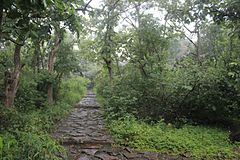
The Rock Shelters of Bhimbetka are 45 kilometers south-east of Bhopal and 9 km from Obedullaganj city in the Raisen District of Madhya Pradesh at the southern edge of the Vindhya Range. South of these rock shelters are successive ranges of the Satpura hills. It is inside the Ratapani Wildlife Sanctuary, embedded in sandstone rocks, in the foothills of the Vindhya Range. The site consists of seven hills: Vinayaka, Bhonrawali, Bhimbetka, Lakha Juar (east and west), Jhondra and Muni Babaki Pahari.
Background
Etymology
Bhimbetka meaning "Bhima's resting place" or "Bhima's lounge", is compound word made of Bhima (second brother among the five Pandavas of Mahabharata) and Baithaka (seat or lounge). According to the native belief, Bhima during his exile used to rest here to interact with the locals. Bhima Worshiped Mata Vaishavi at this location and blessed for concurring the forthcoming war. There is a famous Mata Vaishavi Temple existing at this place since long.
History
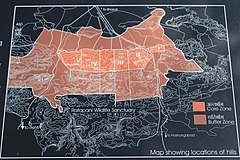

W. Kincaid, a British India era official, first mentioned Bhimbetka in a scholarly paper in 1888. He relied on the information he gathered from adivasis (tribals) about Bhojpur lake in the area and referred to Bhimbetka as a Buddhist site. The first archaeologist to visit a few caves at the site and discover its prehistoric significance was V. S. Wakankar, who saw these rock formations and thought these were similar to those he had seen in Spain and France. He visited the area with a team of archaeologists and reported several prehistoric rock shelters in 1957.
It was only in the 1970s that the scale and true significance of the Bhimbetka rock shelters was discovered and reported. Since then, more than 750 rock shelters have been identified. The Bhimbetka group contains 243 of these, while the Lakha Juar group nearby has 178 shelters. According to Archaeological Survey of India, the evidence suggests that there has been a continuous human settlement here from the Stone Age through the late Acheulian to the late Mesolithic until the 2nd century BCE in these caves. This information is based on the findings from the excavation of the site, the unearthed artifacts and goods, pigments present in deposits, as well as the rock paintings.
The site contains the world's oldest stone walls and floors.
The origin of the raw materials utilized in certain monoliths uncovered at Bhimbetka has been traced back to Barkheda.
The site consisting of 1,892 hectares was declared as protected under Indian laws and came under the management of the Archaeological Survey of India in 1990. It was declared as a World Heritage Site by UNESCO in 2003.
Auditorium cave
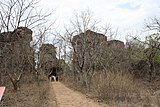 Bhimbetka quartzite towers
Bhimbetka quartzite towers Auditorium cave
Auditorium cave
Of the numerous shelters, the Auditorium cave is one of the significant features of this site. Surrounded by quartzite towers which are visible from several kilometres' distance, the Auditorium rock is the largest shelter at Bhimbetka. Robert G. Bednarik describes the prehistoric Auditorium cave as one with a "cathedral-like" atmosphere, with "its Gothic arches and soaring spaces". Its plan resembles a "right-angled cross" with four of its branches aligned to the four cardinal directions. The main entrance points to the east. At the end of this eastern passage, at the cave's entrance, is a boulder with a near-vertical panel that is distinctive, one visible from distance and all directions. In archaeology literature, this boulder has been dubbed as "Chief's Rock" or "King's Rock", though there is no evidence of any rituals or its role as such. The boulder with the Auditorium cave is the central feature of the Bhimbetka, midst its 754 numbered shelters spread over few kilometres on either side, and nearly 500 locations where rock paintings can be found, states Bednarik.
Rock art and paintings
The rock shelters and caves of Bhimbetka have a large number of paintings. Some of the oldest paintings are dated to 10,000 BCE, but some of the geometric figures date to as recently as the medieval period. The drawings and paintings can be classified under seven different periods. V. S. Wakankar classified the drawings and paintings into seven different periods and dated the earliest paintings to have belonged to the upper Palaeolithic to be as early as 40,000 years ago. The colours used are vegetable colours which have endured through time because the drawings were generally made deep inside a niche or on inner walls.
Period I – (Upper Paleolithic): These are linear representations in green of humans dancing and hunting.
Period II – (Mesolithic): Comparatively small in size the stylised figures in this group show linear decorations on the body. In addition to animals there are human figures and hunting scenes, giving a clear picture of the weapons they used: barbed spears, pointed sticks, bows and arrows. Some scenes are interpreted as depicting tribal war between three tribes symbolised by their animal totems. The depiction of communal dances, birds, musical instruments, mothers and children, pregnant women, men carrying dead animals, drinking and burials appear in rhythmic movement.
Period III – (Chalcolithic) Similar to the paintings of the Mesolithic, these drawings reveal that during this period the cave dwellers of this area were in contact with the agricultural communities of the Malwa plains, exchanging goods with them.
Period IV & V – (Early historic): The figures of this group have a schematic and decorative style and are painted mainly in red, white and yellow. The association is of riders, depiction of religious symbols, tunic-like dresses and the existence of scripts of different periods. The religious beliefs are represented by figures of yakshas, tree gods and magical sky chariots.
Period VI & VII – (Medieval): These paintings are geometric linear and more schematic, but they show degeneration and crudeness in their artistic style. The colors used by the cave dwellers were prepared by combining black manganese oxides, red hematite and charcoal.
One rock, popularly referred to as "Zoo Rock", depicts elephants, barasingha (swamp deer), bison and deer. Paintings on another rock show a peacock, a snake, a deer and the sun. On another rock, two elephants with tusks are painted. Hunting scenes with hunters carrying bows, arrows, swords, and shields also find their place in the community of these pre-historic paintings. In one of the caves, a bison is shown in pursuit of a hunter while his two companions appear to stand helplessly nearby; in another, some horsemen are seen, along with archers. In one painting, a large wild bovine (possibly a gaur or bison) is seen.
Yashodhar Mathpal has conducted a very careful study of the various animals depicted in these rock shelters. He has identified sloth bear, wolf, hyaena, rhinoceros, wild cattle, deer, antelopes, hare, monkeys, anteater, rats, fish, turtle, peafowl, some birds without any details among the wild animals and a domesticated dog. Deer and antelope are amongst the most numerous of the wild animals depicted. The pictures include groups of hunters; one such group is depicted as running away from a rhinoceros. Other groups are engaged in hunting deer, antelopes and other prey. Spear and bow and arrow are the main weapons of hunt; fish and turtle are being caught in a net, and rats are being driven out of their burrows to be caught. The paintings are classified largely in two groups, one as depictions of hunters and food gatherers, and in others as fighters, riding on horses and elephant carrying metal weapons. The first group of paintings date to prehistoric times while second one dates to historic times. Most of the paintings from the historic period depict battles between rulers carrying swords, spears, bows and arrows.
In one of the desolate rock shelters, the painting of a man holding a trident-like staff and dancing has been nicknamed "Nataraj" by archaeologist V. S. Wakankar. It is estimated that paintings in at least 100 rock shelters might have eroded away.
-
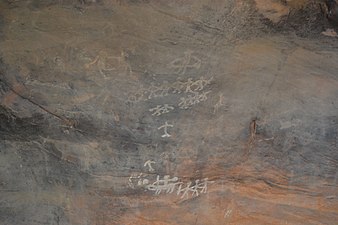 Mesolithic dancers
Mesolithic dancers
-
 A man being attacked by a horned bovine.
A man being attacked by a horned bovine.
-
 people hunting animal
people hunting animal
-
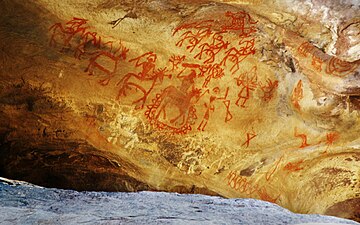 People riding horses holding weapons
People riding horses holding weapons
-
 Man riding elephant
Man riding elephant
-
 An eroded painting in the caves showing a man dancing and holding a trident-like staff
An eroded painting in the caves showing a man dancing and holding a trident-like staff
"Dickinsonia fossils"
See also: Fossil sites in IndiaFossils of Dickinsonia tenuis, an early animal from the Ediacaran Period, were reported from Bhimbetka; they were said to be identical with D. tenuis fossils from the Ediacara Member of Ediacara Hills in South Australia. From this, several paleogeographic conclusions were made, such as the formation of Gondwanaland by 550 million years ago. However, later examination showed that the purported fossil material was simply decayed remnants of a beehive.
Similar sites in India
See also: Archaeology in IndiaSome Mesolithic sites with cave art, tools, paintings, etc are Anangpur caves (Faridabad) and Mangar Bani Caves (Gurugram) in Delhi NCR, and Pahargarh caves (Morena) in Madhya Pradesh.
See also
- Belum Caves
- Cave paintings and other rock art
- Cave paintings in India
- Cumbe Mayo, Peru
- Pahargarh caves
- Petroglyph National Monument
- Rock art
- Rock carvings at Alta
References
- ^ Peter N. Peregrine; Melvin Ember (2003). Encyclopedia of Prehistory: Volume 8: South and Southwest Asia. Springer Science. pp. 315–317. ISBN 978-0-306-46262-7.
- ^ Javid, Ali and Javeed, Tabassum (2008), World Heritage Monuments and Related Edifices in India, Algora Publishing, 2008, pages 15–19
- Agrawal, D.P.; Krishnamurthy, R.V.; Kusumgar, Sheela; Pant, R.K. (1978). "Chronology of Indian prehistory from the Mesolithic period to the Iron Age". Journal of Human Evolution. 7: 37–44. doi:10.1016/S0047-2484(78)80034-7.
The microlithic occupation there is the last one, as the Stone Age started there with Acheulian times. These rock shelters have been used to light fires even up to recent times by the tribals. This is re-fleeted in the scatter of 14C dates from Bhimbetka
- Kerr, Gordon (25 May 2017). A Short History of India: From the Earliest Civilisations to Today's Economic Powerhouse. Oldcastle Books Ltd. p. 17. ISBN 9781843449232.
- Neda Hosse in Tehrani; Shahida Ansari; Kamyar Abdi (2016). "Anthropogenic Processes in Caves/Rock Shelters in Izeh Plain (Iran) and Bhimbetka Region (India)". Bulletin of the Deccan College Research Institute. 76: 237–248. JSTOR 26264790.
the rock shelter site of Bhimbetka in Madhya Pradesh exhibits the earliest traces of human life
- Rock Shelters of Bhimbetka: Advisory Body Evaluation, UNESCO, pages 43–44
- Rock Shelters of Bhimbetka: Advisory Body Evaluation, UNESCO, pages 14–15
- ^ Bhimbetka rock shelters, Encyclopædia Britannica
- ^ Mathpal, Yashodhar (1984). Prehistoric Painting Of Bhimbetka. Abhinav Publications. pp. 220–227. ISBN 9788170171935.
The paintings of the earlier five phases ( A - E ) belong to the prehistoric or Mesolithic stage. The oldest of them may be dated to 10,000 BC
- ^ Alok Kumar Kanungo. Gurudakshina: Facets of Indian Archaeology. British Archaeological Reports. p. 32.
The oldest of them may be dated to 10,000 B.C. or even earlier.
- ^ Tiwari, Shiv Kumar (2000). Riddles of Indian Rockshelter Paintings. Sarup & Sons. p. 189. ISBN 9788176250863.
- ^ Rock Shelters of Bhimbetka (PDF). UNESCO. 2003. p. 16.
- ^ Mithen, Steven (2011). After the Ice: A Global Human History, 20,000 - 5000 BC. Orion. p. 524. ISBN 9781780222592.
- ^ Javid, Ali; Jāvīd, ʻAlī; Javeed, Tabassum (2008). World Heritage Monuments and Related Edifices in India. Algora Publishing. p. 19. ISBN 9780875864846.
- ^ Yashodhar Mathpal, 1984, Prehistoric Painting Of Bhimbetka, Page 214.
- ^ M. L. Varad Pande, Manohar Laxman Varadpande, 1987, History of Indian Theatre, Volume 1, Page 57.
- Sanyal, Sanjeev. Land of the seven rivers : a brief history of India's geography. ISBN 978-0-14-342093-4. OCLC 855957425.
- Deborah M. Pearsall (2008). Encyclopedia of archaeology. Elsevier Academic Press. pp. 1949–1951. ISBN 978-0-12-373643-7.
- Jo McDonald; Peter Veth (2012). A Companion to Rock Art. John Wiley & Sons. pp. 291–293. ISBN 978-1-118-25392-2.
- Rock Shelters of Bhimbetka: Continuity through Antiquity, Art & Environment, Archaeological Survey of India, UNESCO, pages 14–18, 22–23, 30–33
- Bhimbetka: An Accidental Find, Outlook, 22 June 2020.
- ^ Rock Shelters of Bhimbetka: Continuity through Antiquity, Art & Environment, Archaeological Survey of India, UNESCO, page 54
- "Rock Shelters of Bhimbetka". World Heritage Site. Archived from the original on 8 March 2007. Retrieved 15 February 2007.
- Rock Shelters of Bhimbetka: Continuity through Antiquity, Art & Environment, Archaeological Survey of India, UNESCO, pages 15–16, 22–23, 45, 54–60
- Kalyan Kumar Chakravarty; Robert G. Bednarik. Indian Rock Art and Its Global Context. Motilal Banarsidass. p. 29.
- "Bhimbetka (India) No. 925" (PDF). UNESCO World Heritage Centre. Retrieved 28 April 2012.
- Rock Shelters of Bhimbetka: Continuity through Antiquity, Art & Environment, Archaeological Survey of India, UNESCO, pages 10, 53
- World Heritage Sites – Rock Shelters of Bhimbetka Archived 27 March 2014 at the Wayback Machine, Archaeological Survey of India
- ^ Robert G Bednarik (1996), The cupules on Chief's Rock, Auditorium Cave, Bhimbetka, The Artifact: Journal of the Archaeological and Anthropological Society of Victoria, Volume 19, pages 63–71
- Robert Bednarik (1993), Palaeolithic Art in India, Man and Environment, Volume 18, Number 2, pages 33–40
- Singh, Manoj Kumar (2014). "Bhimbetka Rockshelters". Encyclopedia of Global Archaeology. Springer New York. pp. 867–870. doi:10.1007/978-1-4419-0465-2_2286. ISBN 978-1-4419-0426-3.
- Agrawal, D.P.; Kharakwal, J.S. (1998). Central Himalayas: An Archaeological, Linguistic, and Cultural Synthesis. Aryan Books International. p. 66. ISBN 978-81-7305-132-6.
Based on C - 14 dates they are placed between 40,000 and 25,000 BP ( Wakankar 1987)
- Bednarik, Robert G. (1994). "Art Origins". Anthropos. 89 (1/3). Anthropos Institut: 169–180. ISSN 0257-9774. JSTOR 40463849. Retrieved 3 November 2022.
- Dubey-Pathak, Meenakshi (2014). "Rock art of the Bhimbetka period in India" (PDF). Adoranten 2014. Tanums Hällristningsmuseum Underslös. Retrieved 13 September 2021.
- ^ Dance In Indian Painting, Page xv.
- D. P. Agrawal, J. S. Kharakwal. South Asian Prehistory: A Multidisciplinary study. Aryan Books International. p. 149.
- Mathpal, Yashodhar (1984). Prehistoric Painting Of Bhimbetka. Abhinav Publications. p. 225.
- ^ Javid, Ali and Javeed, Tabassum (2008). World Heritage Monuments and Related Edifices in India. Algora Publishing. p. 20.
{{cite book}}: CS1 maint: multiple names: authors list (link) - Chakravarty, Kalyan Kumar. Rock-art of India: Paintings and Engravings. Arnold-Heinemann. p. 123.
Nataraj figures from BHIM III E-19 and one from III F −16 are well decorated in fierce mood. Probably they represent conception of a fierce deity like Vedic Rudra.(Wa.kankar, op. cit)'.
- Shiv Kumar Tiwari. Riddles of Indian Rockshelter Paintings. Sarup & Sons. p. 245.
- Mithen, Steven (2006). After the Ice: A Global Human History, 20,000–5000 BC. Harvard University Press. p. 401. ISBN 9780674019997.
- Retallack, Gregory J.; Matthews, Neffra A.; Master, Sharad; Khangar, Ranjit G.; Khan, Merajuddin (2021). "Dickinsonia discovered in India and late Ediacaran biogeography". Gondwana Research. 90: 165–170. doi:10.1016/j.gr.2020.11.008. S2CID 229451488.
- Meert, Joseph G.; Pandit, Manoj K.; Kwafo, Samuel; Singha, Ananya (13 January 2023). "Stinging News: 'Dickinsonia' discovered in the Upper Vindhyan of India Not Worth the Buzz". Gondwana Research. 117: 1–7. doi:10.1016/j.gr.2023.01.003. ISSN 1342-937X. S2CID 255846878.
External links
- UNESCO World Heritage: Rock Shelters of Bhimbetka
- Prehistoric Art of Bhimbetka
- Bhimbetka Gallery by A. N. Maheshwari
- Pre-historic Paintings of Bhimbetka by L. L. Kamat
- The Rock Art of Central India
- TRACCE Online Rock Art Bulletin photogallery by Sarbanidas Roy
| By state |
| ||||||
|---|---|---|---|---|---|---|---|
| By city | |||||||
| Types | |||||||
| Sites |
| ||||||
| Culture | |||||||
| Transport | |||||||
| Agencies |
| ||||||
| Related | |||||||
| Prehistoric technology | |||||||||||||||||||||
|---|---|---|---|---|---|---|---|---|---|---|---|---|---|---|---|---|---|---|---|---|---|
| |||||||||||||||||||||
| |||||||||||||||||||||
| |||||||||||||||||||||
| Narmada basin | |||||||||
|---|---|---|---|---|---|---|---|---|---|
| Rivers |
| ||||||||
| Dams, barrages | |||||||||
| Geographical features/ regions | |||||||||
| Riparian districts |
| ||||||||
| Cities | |||||||||
| Languages/ people | |||||||||
| Controversies | |||||||||
| Transport | |||||||||
| Other basins | |||||||||
- 1888 archaeological discoveries
- World Heritage Sites in India
- Caves of Madhya Pradesh
- Archaeological sites in Madhya Pradesh
- Tourist attractions in Bhopal
- Prehistoric art in India
- Tourist attractions in Raisen district
- Rock art in India
- Caves containing pictograms in India
- Rock shelters
- World Heritage Sites in Madhya Pradesh
- Prehistoric sites in India